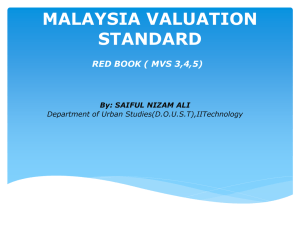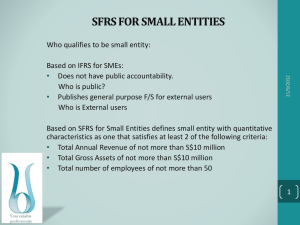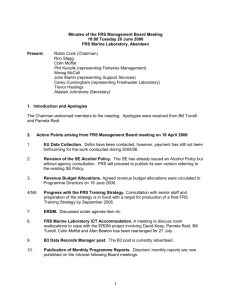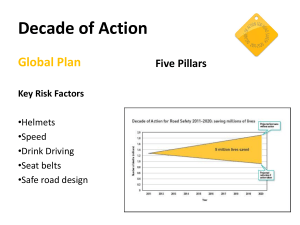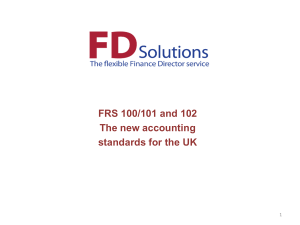FRS102 presentation
advertisement
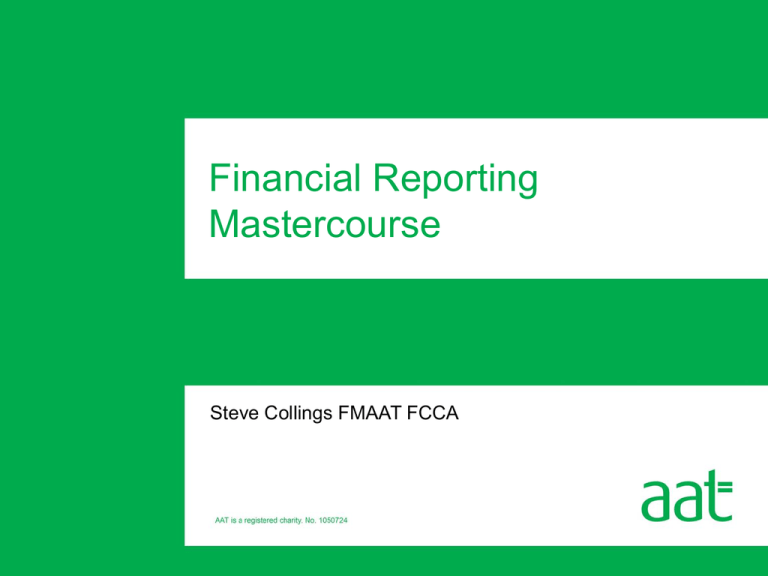
Financial Reporting Mastercourse Steve Collings FMAAT FCCA Introduction • New UK GAAP overview • Key differences between ‘old’ and ‘new’ GAAP • Transitioning across to new UK GAAP • The FRSSE • Micro-entities • Key points Why the need for change? • Current GAAP is overly complex and voluminous • Financial reporting practices have evolved • FRED 44 exposed as the FRSME which was largely based on IFRS for SMEs • Very controversial responses due to elimination of many established accounting practices and the concept of ‘public accountability’ • ASB went back to the ‘drawing board’ and re-exposed FRED 44 as FRED 48 Why the need for change? • FRED 48 was to become FRS 102 and o Eliminated the tier system for large, small-medium and micro entities o Introduced accounting treatments permitted under UK GAAP o Incorporated guidance for PBEs • In addition FRS 100 and 101 were introduced • FRS 100 outlines which entities will use which standard • FRS 100 offers a reduced disclosure framework for subsidiary companies Why the need for change? • FRS 102 is the new UK GAAP • Smaller companies will still be able to use the FRSSE (January 2015) • New micro-entity legislation has also been introduced (covered later) • FRS 102 re-issued August 2014 incorporating amendments to financial instruments and hedge accounting Main differences in ‘old’ v ‘new’ • Notable differences inherent with a new FR regime • Understanding the differences is crucial in identifying impact on clients’ accounts or company reports • UK accountants are being advised to start gathering data NOW (see why later) Main differences: fixed assets • FRS 15 goes into lots of detail re ‘subsequent expenditure’ • SE merely glossed over in FRS 102 (para 17.5) • Users’ directed to Section 2 Concepts and Pervasive Principles to determine appropriate a/c treatment • Transaction = capital if the expense enhances an asset in any way • Major spare parts and standby equipment are part of the cost of an asset, not in inventory/stock Main differences: investment properties • Significant differences relating to the accounting treatment for investment properties • SSAP 19 uses a ‘revaluation reserve’ to take fair value gains/losses • Para 16.7 of FRS 102 prohibits this a/c treatment – FV gains/losses go to P&L • Key point to emphasise is that FV gains are NOT distributable as a dividend • Advice is to keep a track of undistributable reserves Main differences: investment properties • On transition, existing revaluation reserves are to go into retained earnings (reserves) or another appropriate category of equity • This treatment proving to be controversial – why? • Investment properties at fair value will also require deferred tax to be accounted for Main differences: leases • Concept of finance v operating still the case in FRS 102 • No 90% benchmark in FRS 102 (replaced with ‘substantially all’) • FRS 102 offers eight additional indicators that a lease is a FINANCE lease • Future changes to leasing may be likely if IASB/FASB standard on leasing is overhauled (still in heated debate) Main differences: cash flow statement • Significant presentational changes in FRS 102 v FRS 1 • FRS 1 = nine standard cash flow classifications • FRS 102 = three: operating, investing and financing • Corporation tax paid = operating • Interest paid = operating • Two methods of preparation carried over into FRS 102: direct and indirect method Main differences: employee benefits • No specific standard that requires short-term employee benefits unpaid at he y/e to be accrued • However FRS 12 does cite an example of unpaid holiday pay as meeting the definition of a liability • Section 28 does require unpaid employee benefits that are paid in the next a/p to be accrued at the y/e • This treatment may prove problematic for larger companies where this information is not kept centrally Main differences: prior period adjustments • FRS 3 requires correction of ‘fundamental’ errors by way of a PYA • ‘Fundamental’ is taken to mean that the truth and fairness of the accounts are destroyed by the error • FRS 102 Section 20 requires a PYA for errors which are material • Hence more corrections will be done by way of a PYA in FRS 102 Main differences: revenue recognition • Slight variations to the wording in Section 23 as opposed to UITF 40 (ANG FRS 5) • UITF 40 uses the term ‘right to consideration’ • FRS 102 uses the term ‘consideration received or receivable’ • Care must be exercised in the interpretation aspects to ensure appropriate amounts of revenue are recognised • FRS 102 refers to a ‘specific’ and a ‘significant’ act Main differences: revenue recognition • When a specific act is more significant than any other act, revenue recognition is postponed until the significant act is executed • UITF 40 is more prohibitive in that it requires revenue to be recognised when a ‘milestone’ is passed or a ‘critical event’ takes place • For service contracts where the outcome cannot be reliably estimated revenue is recognised to the extent of costs incurred (hence nil profit) Main differences: revenue recognition • SSAP 9 says that a proportion of the total contract value is recognised in such situations using a zero estimate profit (hence still the same overall outcome but a different route) • FRC have commented that if entities abuse the wording in Section 23, an Abstract will be issued clarifying the position Main differences: deferred tax • Deferred tax uses a timing difference ‘plus’ approach • Plus part builds on existing FRS 19 but introduces three additional considerations: o Revaluations of non-monetary assets o Fair values on business combinations o Unremitted earnings on overseas subs or associates • FRS 102 prohibits deferred tax balances being discounted (very rare in practice to discount such balances) Main differences: defined benefit pension plans • No explicit requirement to use an actuary in FRS 102 as opposed to FRS 17 • Entity must be able to carry out the calculations without undue cost or effort (highly unlikely) • Changes to the way in which the net interest expense is calculated • No requirement for comprehensive annual valuations Main differences: stock valuations • SSAP 9 currently allows LIFO (but with limited use only) • FRS 102 does not permit entities to use LIFO as a cost flow assumption (FIFO or AVCO only) • Will prove problematic for some companies hence change ASAP to avoid transitional issues (changing now will = a change in a/c policy) Main differences: accounting policies • Where FRS 102 does not deal with a transaction/event management must develop an accounting policy which is : o Relevant and o Reliable • FRS 18 very similar but in some cases the end result and impact on profit/loss may not necessarily be the same Main differences: terminology • FRS 102 uses international terminology (e.g. balance sheet = statement of financial position) • Likely to see a ‘mix and match’ of terminology e.g. Vodafone has a consolidated SoFP but Whitbread has a consolidated balance sheet • Paragraph 3.22 allows alternative titles to be used for statements provided they are not misleading Applying FRS 102 for the first time • Mandatory for a/p commencing on/after 1 January 2015 • Earlier adoption permissible • Advice is to try and do some ‘dry runs’ to help identify potential problems • Section 35 to FRS 102 outlines the steps necessary • Work out the date of transition and then work back and determine accounting policy changes (see case study) Applying FRS 102 for the first time • Entities must make an ‘explicit and unreserved’ statement of compliance with FRS 102 • P12 of the course notes illustrates how this may look • FRS 102 also explains what a ‘complete’ set of financial statements must comprise • Four procedures in Section 35 to prepare the opening FRS 102 balance sheet at the date of transition: Applying FRS 102 for the first time 1. Recognise all assets and liabilities required by FRS 102 2. Not recognise items as assets/liabilities if FRS 102 does not permit such 3. Reclassify items according to FRS 102 (e.g. investment property revaluation reserve) 4. Apply FRS 102 going forward in measuring all recognised assets and liabilities Applying FRS 102 for the first time Refer to case study. Applying FRS 102 for the first time • There are a number of exemptions (mandatory and optional) that entities can take in Section 35 which are designed to make the transition easier • Page 13 to 15 outline these exemptions • Additional disclosures are required in the first set of FRS 102 financial statements to include: Applying FRS 102 for the first time • A description of the nature of each change in a/c policy • Reconciliations of equity under previous GAAP to equity under FRS 102 for the following dates: o The date of transition to FRS 102; and o The end of the latest period presented in the entity’s most recent annual financial statements determined in accordance with its previous FR framework • A reconciliation of the profit/loss determined under old GAAP to the profit/loss determined under FRS 102 Applying FRS 102 for the first time • If errors are discovered on transition, above reconciliations must distinguish the correction of errors from changes in a/c policy • If the entity did not prepare financial statements for previous periods, that fact should be made in the first set of FRS 102 financial statements Micro-entities • New legislation introduced on 1/12/13 (SI 2013/3008) allowing micro-entities to take advantage of significant disclosure reductions • A company qualifies as a micro-entity if it meets at least 2 of the following 3 conditions (for 2 consecutive years): o Turnover not more than £632,000 o Gross assets not more than £316,000 o Average number of employees not more than 10 Micro-entities • If the company has a short a/p then the turnover figure is adjusted proportionately (e.g. 9/12ths) • Micro-entity regime does not apply to: o o o o o o Investment undertakings Financial holding undertakings Credit institutions Insurance undertakings Charities LLPs Micro-entities • Optional for clients • ‘Deeming provisions’ relating to the T&F concept • Legislation does NOT affect the recognition and measurement of amounts – merely the disclosures • Micro-entities regime: o Withdraws the use of the revaluation model for TFA o Withdraws the choice to measure fixed asset investments at market value o Withdraws the use of the revaluation model for investment properties Micro-entities • FRSME due to be issued by the FRC • Further simplifications in the FRSME include: Financial instruments at cost No deferred tax No requirement to account for equity-settled share-based payments prior to share issue Defined benefit pension scheme = defined contribution scheme No option to capitalise borrowing costs No requirement to apply sections of FRS 102 not likely to affect micro-entities Micro-entities • Very mixed opinions over this legislation • FRSSE has been changed as a result of the introduction of the micro-entities regime • Illustrative accounts shown in the course notes (but these may be subjected to change following finalisation of the requirements by FRC) • Companies House will require either a ‘full’ set of the micro-entity accounts or the balance sheet with the notes (i.e. no directors’ report/P&L)
